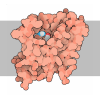+ Open data
Open data
- Basic information
Basic information
| Entry | Database: PDB / ID: 7bxu | ||||||
|---|---|---|---|---|---|---|---|
| Title | CLC-7/Ostm1 membrane protein complex | ||||||
 Components Components |
| ||||||
 Keywords Keywords | MEMBRANE PROTEIN / complex / lysosome / transporter | ||||||
| Function / homology |  Function and homology information Function and homology informationtransepithelial chloride transport / chloride:proton antiporter activity / response to pH / chloride transmembrane transporter activity / chloride channel activity / chloride channel complex / osteoclast differentiation / Stimuli-sensing channels / lysosomal membrane / intracellular membrane-bounded organelle ...transepithelial chloride transport / chloride:proton antiporter activity / response to pH / chloride transmembrane transporter activity / chloride channel activity / chloride channel complex / osteoclast differentiation / Stimuli-sensing channels / lysosomal membrane / intracellular membrane-bounded organelle / ATP binding / membrane / cytosol Similarity search - Function | ||||||
| Biological species |  Homo sapiens (human) Homo sapiens (human) | ||||||
| Method | ELECTRON MICROSCOPY / single particle reconstruction / cryo EM / Resolution: 3.7 Å | ||||||
 Authors Authors | Zhang, S.S. / Yang, M.J. | ||||||
| Funding support |  China, 1items China, 1items
| ||||||
 Citation Citation |  Journal: Sci Adv / Year: 2020 Journal: Sci Adv / Year: 2020Title: Molecular insights into the human CLC-7/Ostm1 transporter. Authors: Sensen Zhang / Yang Liu / Bing Zhang / Jun Zhou / Tianyu Li / Zhiqiang Liu / Yang Li / Maojun Yang /  Abstract: CLC family proteins translocate chloride ions across cell membranes to maintain the membrane potential, regulate the transepithelial Cl transport, and control the intravesicular pH among different ...CLC family proteins translocate chloride ions across cell membranes to maintain the membrane potential, regulate the transepithelial Cl transport, and control the intravesicular pH among different organelles. CLC-7/Ostm1 is an electrogenic Cl/H antiporter that mainly resides in lysosomes and osteoclast ruffled membranes. Mutations in human CLC-7/Ostm1 lead to lysosomal storage disorders and severe osteopetrosis. Here, we present the cryo-electron microscopy (cryo-EM) structure of the human CLC-7/Ostm1 complex and reveal that the highly glycosylated Ostm1 functions like a lid positioned above CLC-7 and interacts extensively with CLC-7 within the membrane. Our complex structure reveals a functionally crucial domain interface between the amino terminus, TMD, and CBS domains of CLC-7. Structural analyses and electrophysiology studies suggest that the domain interaction interfaces affect the slow gating kinetics of CLC-7/Ostm1. Thus, our study deepens understanding of CLC-7/Ostm1 transporter and provides insights into the molecular basis of the disease-related mutations. | ||||||
| History |
|
- Structure visualization
Structure visualization
| Movie |
 Movie viewer Movie viewer |
|---|---|
| Structure viewer | Molecule:  Molmil Molmil Jmol/JSmol Jmol/JSmol |
- Downloads & links
Downloads & links
- Download
Download
| PDBx/mmCIF format |  7bxu.cif.gz 7bxu.cif.gz | 313.9 KB | Display |  PDBx/mmCIF format PDBx/mmCIF format |
|---|---|---|---|---|
| PDB format |  pdb7bxu.ent.gz pdb7bxu.ent.gz | 247.5 KB | Display |  PDB format PDB format |
| PDBx/mmJSON format |  7bxu.json.gz 7bxu.json.gz | Tree view |  PDBx/mmJSON format PDBx/mmJSON format | |
| Others |  Other downloads Other downloads |
-Validation report
| Arichive directory |  https://data.pdbj.org/pub/pdb/validation_reports/bx/7bxu https://data.pdbj.org/pub/pdb/validation_reports/bx/7bxu ftp://data.pdbj.org/pub/pdb/validation_reports/bx/7bxu ftp://data.pdbj.org/pub/pdb/validation_reports/bx/7bxu | HTTPS FTP |
|---|
-Related structure data
| Related structure data |  30238MC M: map data used to model this data C: citing same article ( |
|---|---|
| Similar structure data |
- Links
Links
- Assembly
Assembly
| Deposited unit | 
|
|---|---|
| 1 |
|
- Components
Components
| #1: Protein | Mass: 37290.570 Da / Num. of mol.: 2 Source method: isolated from a genetically manipulated source Source: (gene. exp.)  Homo sapiens (human) / Gene: OSTM1, GL, HSPC019, UNQ6098/PRO21201 / Production host: Homo sapiens (human) / Gene: OSTM1, GL, HSPC019, UNQ6098/PRO21201 / Production host:  Homo sapiens (human) / References: UniProt: Q86WC4 Homo sapiens (human) / References: UniProt: Q86WC4#2: Protein | Mass: 88773.875 Da / Num. of mol.: 2 Source method: isolated from a genetically manipulated source Source: (gene. exp.)  Homo sapiens (human) / Gene: CLCN7 / Production host: Homo sapiens (human) / Gene: CLCN7 / Production host:  Homo sapiens (human) / References: UniProt: P51798 Homo sapiens (human) / References: UniProt: P51798#3: Sugar | ChemComp-NAG / Has ligand of interest | N | Has protein modification | Y | |
|---|
-Experimental details
-Experiment
| Experiment | Method: ELECTRON MICROSCOPY |
|---|---|
| EM experiment | Aggregation state: PARTICLE / 3D reconstruction method: single particle reconstruction |
- Sample preparation
Sample preparation
| Component | Name: lysosomal membrane protein complex / Type: COMPLEX / Entity ID: #1-#2 / Source: RECOMBINANT |
|---|---|
| Molecular weight | Experimental value: NO |
| Source (natural) | Organism:  Homo sapiens (human) Homo sapiens (human) |
| Source (recombinant) | Organism:  Homo sapiens (human) Homo sapiens (human) |
| Buffer solution | pH: 7.2 |
| Specimen | Embedding applied: NO / Shadowing applied: NO / Staining applied: NO / Vitrification applied: YES |
| Vitrification | Cryogen name: ETHANE |
- Electron microscopy imaging
Electron microscopy imaging
| Experimental equipment |  Model: Titan Krios / Image courtesy: FEI Company |
|---|---|
| Microscopy | Model: FEI TITAN KRIOS |
| Electron gun | Electron source:  FIELD EMISSION GUN / Accelerating voltage: 300 kV / Illumination mode: FLOOD BEAM FIELD EMISSION GUN / Accelerating voltage: 300 kV / Illumination mode: FLOOD BEAM |
| Electron lens | Mode: BRIGHT FIELD |
| Image recording | Electron dose: 50 e/Å2 / Film or detector model: GATAN K2 SUMMIT (4k x 4k) |
- Processing
Processing
| CTF correction | Type: PHASE FLIPPING AND AMPLITUDE CORRECTION |
|---|---|
| Symmetry | Point symmetry: C2 (2 fold cyclic) |
| 3D reconstruction | Resolution: 3.7 Å / Resolution method: FSC 0.143 CUT-OFF / Num. of particles: 3956 / Symmetry type: POINT |
 Movie
Movie Controller
Controller





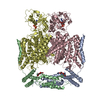
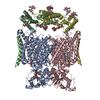
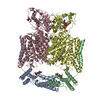
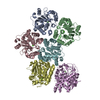
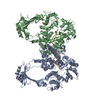
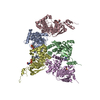
 PDBj
PDBj